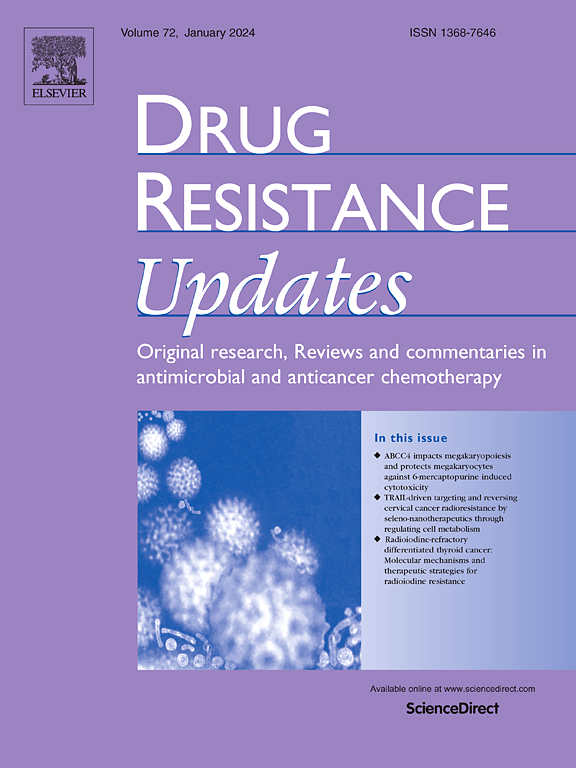大范围的功能缺失突变暗示了对新的或重新设计的抗结核药物的原有抗药性。
IF 15.8
1区 医学
Q1 PHARMACOLOGY & PHARMACY
引用次数: 0
摘要
背景:在过去十年中,有五种新药或改变用途药物(NRDs)被批准用于治疗耐多药结核病:贝达喹啉(bedaquiline)、氯法齐明(clofazimine)、利奈唑胺(linezolid)、德拉马尼(delamanid)和普托马尼(pretomanid)。不幸的是,对这些药物产生耐药性的速度比预期的要快,这可能是由于新菌株预先存在耐药性。以前对耐药性快速出现的研究大多包括短变体。我们首次利用新组装的基因组,并系统地纳入了结构变异(SV)和异质性,以全面研究这种快速出现的情况。我们的研究显示了既存抗药性的高流行率,确定了新的抗药性标记,并为在未来的药物开发中预防既存抗药性奠定了基础:方法:首先,通过系统性文献回顾发现了 13 个基因中的 313 种 NRD 耐药性变异。接下来,我们利用在药物计划使用前收集的 409 个全球不同的临床分离株(308 个具有多重耐药性,106 个具有全新组装的基因组),对这 13 个基因的常规变异、结构变异和异质性变异进行了全面研究:我们发现了 5 个以前报道过的和 67 个新的假定 NRD 耐药性变异。这些变异包括 2 个启动子突变(8/409 个分离株)、13 个框架移位(21/409)、6 个 SV(9/409)、35 个异质框架移位(32/409)和 11 个异质 SV(12/106)。地拉那米和前马尼耐药突变最普遍(48/409),而利奈唑胺耐药突变最少(8/409):解释:至少对一种 NRD 产生耐药性的原有突变非常普遍(85/409,21%)。这主要是由于负责原药激活和外排泵调节的基因发生了功能缺失突变。这些预先存在的突变可能是通过对冲策略或与甲硝唑等非结核病药物的交叉耐药性产生的。未来可能通过非基本基因的功能缺失而产生抗药性的药物,也可能存在前期抗药性。本文用于全面评估既往耐药性(尤其是 SV 和异质性)的方法可在早期药物开发阶段降低这种风险。本文章由计算机程序翻译,如有差异,请以英文原文为准。
Widespread loss-of-function mutations implicating preexisting resistance to new or repurposed anti-tuberculosis drugs
Background
Five New or Repurposed Drugs (NRDs) were approved in the last decade for treatment of multi-drug resistant tuberculosis: bedaquiline, clofazimine, linezolid, delamanid, and pretomanid. Unfortunately, resistance to these drugs emerged faster than anticipated, potentially due to preexisting resistance in naïve strains. Previous investigations into the rapid emergence have mostly included short variants. For the first time, we utilize de novo-assembled genomes, and systematically include Structural Variations (SV) and heterogeneity to comprehensively study this rapid emergence. We show high prevalence of preexisting resistance, identify novel markers of resistance, and lay the foundation for preventing preexisting resistance in future drug development.
Methods
First, a systematic literature review revealed 313 NRD resistance variants in 13 genes. Next, 409 globally diverse clinical isolates collected prior to the drugs’ programmatic use (308 were multidrug resistant, 106 had de novo assembled genomes) were utilized to study the 13 genes comprehensively for conventional, structural, and heterogeneous variants.
Findings
We identified 5 previously reported and 67 novel putative NRD resistance variants. These variants were 2 promoter mutations (in 8/409 isolates), 13 frameshifts (21/409), 6 SVs (9/409), 35 heterogeneous frameshifts (32/409) and 11 heterogeneous SVs (12/106). Delamanid and pretomanid resistance mutations were most prevalent (48/409), while linezolid resistance mutations were least prevalent (8/409).
Interpretation
Preexisting mutations implicated in resistance to at least one NRD was highly prevalent (85/409, 21 %). This was mostly caused by loss-of-function mutations in genes responsible for prodrug activation and efflux pump regulation. These preexisting mutations may have emerged through a bet-hedging strategy, or through cross-resistance with non-tuberculosis drugs such as metronidazole. Future drugs that could be resisted through loss-of-function in non-essential genes may suffer from preexisting resistance. The methods used here for comprehensive preexisting resistance assessment (especially SVs and heterogeneity) may mitigate this risk during early-stage drug development.
求助全文
通过发布文献求助,成功后即可免费获取论文全文。
去求助
来源期刊

Drug Resistance Updates
医学-药学
CiteScore
26.20
自引率
11.90%
发文量
32
审稿时长
29 days
期刊介绍:
Drug Resistance Updates serves as a platform for publishing original research, commentary, and expert reviews on significant advancements in drug resistance related to infectious diseases and cancer. It encompasses diverse disciplines such as molecular biology, biochemistry, cell biology, pharmacology, microbiology, preclinical therapeutics, oncology, and clinical medicine. The journal addresses both basic research and clinical aspects of drug resistance, providing insights into novel drugs and strategies to overcome resistance. Original research articles are welcomed, and review articles are authored by leaders in the field by invitation.
Articles are written by leaders in the field, in response to an invitation from the Editors, and are peer-reviewed prior to publication. Articles are clear, readable, and up-to-date, suitable for a multidisciplinary readership and include schematic diagrams and other illustrations conveying the major points of the article. The goal is to highlight recent areas of growth and put them in perspective.
*Expert reviews in clinical and basic drug resistance research in oncology and infectious disease
*Describes emerging technologies and therapies, particularly those that overcome drug resistance
*Emphasises common themes in microbial and cancer research
 求助内容:
求助内容: 应助结果提醒方式:
应助结果提醒方式:


